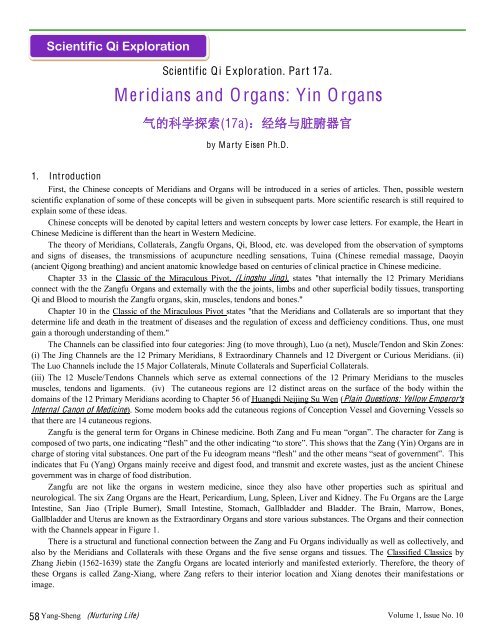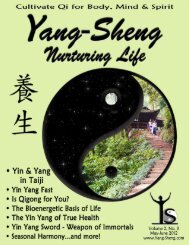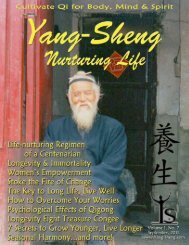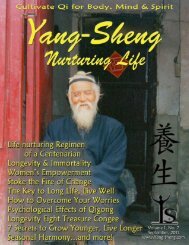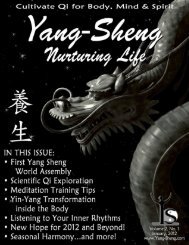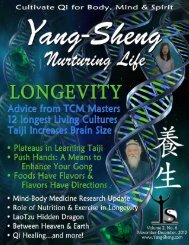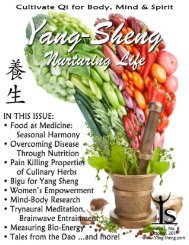Download the December issue of Yang-Sheng as
Download the December issue of Yang-Sheng as
Download the December issue of Yang-Sheng as
You also want an ePaper? Increase the reach of your titles
YUMPU automatically turns print PDFs into web optimized ePapers that Google loves.
Scientific Qi Exploration<br />
Scientific Qi Exploration. Part 17a.<br />
Meridians and O rgans: Yin O rgans<br />
气的科学探索(17a):经络与脏腑器官<br />
by Marty Eisen Ph.D.<br />
1. Introduction<br />
First, <strong>the</strong> Chinese concepts <strong>of</strong> Meridians and Organs will be introduced in a series <strong>of</strong> articles. Then, possible western<br />
scientific explanation <strong>of</strong> some <strong>of</strong> <strong>the</strong>se concepts will be given in subsequent parts. More scientific research is still required to<br />
explain some <strong>of</strong> <strong>the</strong>se ide<strong>as</strong>.<br />
Chinese concepts will be denoted by capital letters and western concepts by lower c<strong>as</strong>e letters. For example, <strong>the</strong> Heart in<br />
Chinese Medicine is different than <strong>the</strong> heart in Western Medicine.<br />
The <strong>the</strong>ory <strong>of</strong> Meridians, Collaterals, Zangfu Organs, Qi, Blood, etc. w<strong>as</strong> developed from <strong>the</strong> observation <strong>of</strong> symptoms<br />
and signs <strong>of</strong> dise<strong>as</strong>es, <strong>the</strong> transmissions <strong>of</strong> acupuncture needling sensations, Tuina (Chinese remedial m<strong>as</strong>sage, Daoyin<br />
(ancient Qigong breathing) and ancient anatomic knowledge b<strong>as</strong>ed on centuries <strong>of</strong> clinical practice in Chinese medicine.<br />
Chapter 33 in <strong>the</strong> Cl<strong>as</strong>sic <strong>of</strong> <strong>the</strong> Miraculous Pivot, (Lingshu Jing), states "that internally <strong>the</strong> 12 Primary Meridians<br />
connect with <strong>the</strong> <strong>the</strong> Zangfu Organs and externally with <strong>the</strong> <strong>the</strong> joints, limbs and o<strong>the</strong>r superficial bodily t<strong>issue</strong>s, transporting<br />
Qi and Blood to mourish <strong>the</strong> Zangfu organs, skin, muscles, tendons and bones."<br />
Chapter 10 in <strong>the</strong> Cl<strong>as</strong>sic <strong>of</strong> <strong>the</strong> Miraculous Pivot states "that <strong>the</strong> Meridians and Collaterals are so important that <strong>the</strong>y<br />
determine life and death in <strong>the</strong> treatment <strong>of</strong> dise<strong>as</strong>es and <strong>the</strong> regulation <strong>of</strong> excess and defficiency conditions. Thus, one must<br />
gain a thorough understanding <strong>of</strong> <strong>the</strong>m."<br />
The Channels can be cl<strong>as</strong>sified into four categories: Jing (to move through), Luo (a net), Muscle/Tendon and Skin Zones:<br />
(i) The Jing Channels are <strong>the</strong> 12 Primary Meridians, 8 Extraordinary Channels and 12 Divergent or Curious Meridians. (ii)<br />
The Luo Channels include <strong>the</strong> 15 Major Collaterals, Minute Collaterals and Superficial Collaterals.<br />
(iii) The 12 Muscle/Tendons Channels which serve <strong>as</strong> external connections <strong>of</strong> <strong>the</strong> 12 Primary Meridians to <strong>the</strong> muscles<br />
muscles, tendons and ligaments. (iv) The cutaneous regions are 12 distinct are<strong>as</strong> on <strong>the</strong> surface <strong>of</strong> <strong>the</strong> body within <strong>the</strong><br />
domains <strong>of</strong> <strong>the</strong> 12 Primary Meridians acording to Chapter 56 <strong>of</strong> Huangdi Neijing Su Wen (Plain Questions: Yellow Emperor's<br />
Internal Canon <strong>of</strong> Medicine). Some modern books add <strong>the</strong> cutaneous regions <strong>of</strong> Conception Vessel and Governing Vessels so<br />
that <strong>the</strong>re are 14 cutaneous regions.<br />
Zangfu is <strong>the</strong> general term for Organs in Chinese medicine. Both Zang and Fu mean “organ”. The character for Zang is<br />
composed <strong>of</strong> two parts, one indicating “flesh” and <strong>the</strong> o<strong>the</strong>r indicating “to store”. This shows that <strong>the</strong> Zang (Yin) Organs are in<br />
charge <strong>of</strong> storing vital substances. One part <strong>of</strong> <strong>the</strong> Fu ideogram means “flesh” and <strong>the</strong> o<strong>the</strong>r means “seat <strong>of</strong> government”. This<br />
indicates that Fu (<strong>Yang</strong>) Organs mainly receive and digest food, and transmit and excrete w<strong>as</strong>tes, just <strong>as</strong> <strong>the</strong> ancient Chinese<br />
government w<strong>as</strong> in charge <strong>of</strong> food distribution.<br />
Zangfu are not like <strong>the</strong> organs in western medicine, since <strong>the</strong>y also have o<strong>the</strong>r properties such <strong>as</strong> spiritual and<br />
neurological. The six Zang Organs are <strong>the</strong> Heart, Pericardium, Lung, Spleen, Liver and Kidney. The Fu Organs are <strong>the</strong> Large<br />
Intestine, San Jiao (Triple Burner), Small Intestine, Stomach, Gallbladder and Bladder. The Brain, Marrow, Bones,<br />
Gallbladder and Uterus are known <strong>as</strong> <strong>the</strong> Extraordinary Organs and store various substances. The Organs and <strong>the</strong>ir connection<br />
with <strong>the</strong> Channels appear in Figure 1.<br />
There is a structural and functional connection between <strong>the</strong> Zang and Fu Organs individually <strong>as</strong> well <strong>as</strong> collectively, and<br />
also by <strong>the</strong> Meridians and Collaterals with <strong>the</strong>se Organs and <strong>the</strong> five sense organs and t<strong>issue</strong>s. The Cl<strong>as</strong>sified Cl<strong>as</strong>sics by<br />
Zhang Jiebin (1562-1639) state <strong>the</strong> Zangfu Organs are located interiorly and manifested exteriorly. Therefore, <strong>the</strong> <strong>the</strong>ory <strong>of</strong><br />
<strong>the</strong>se Organs is called Zang-Xiang, where Zang refers to <strong>the</strong>ir interior location and Xiang denotes <strong>the</strong>ir manifestations or<br />
image.<br />
58 <strong>Yang</strong>-<strong>Sheng</strong> (Nurturing Life) Volume 1, Issue No. 10


